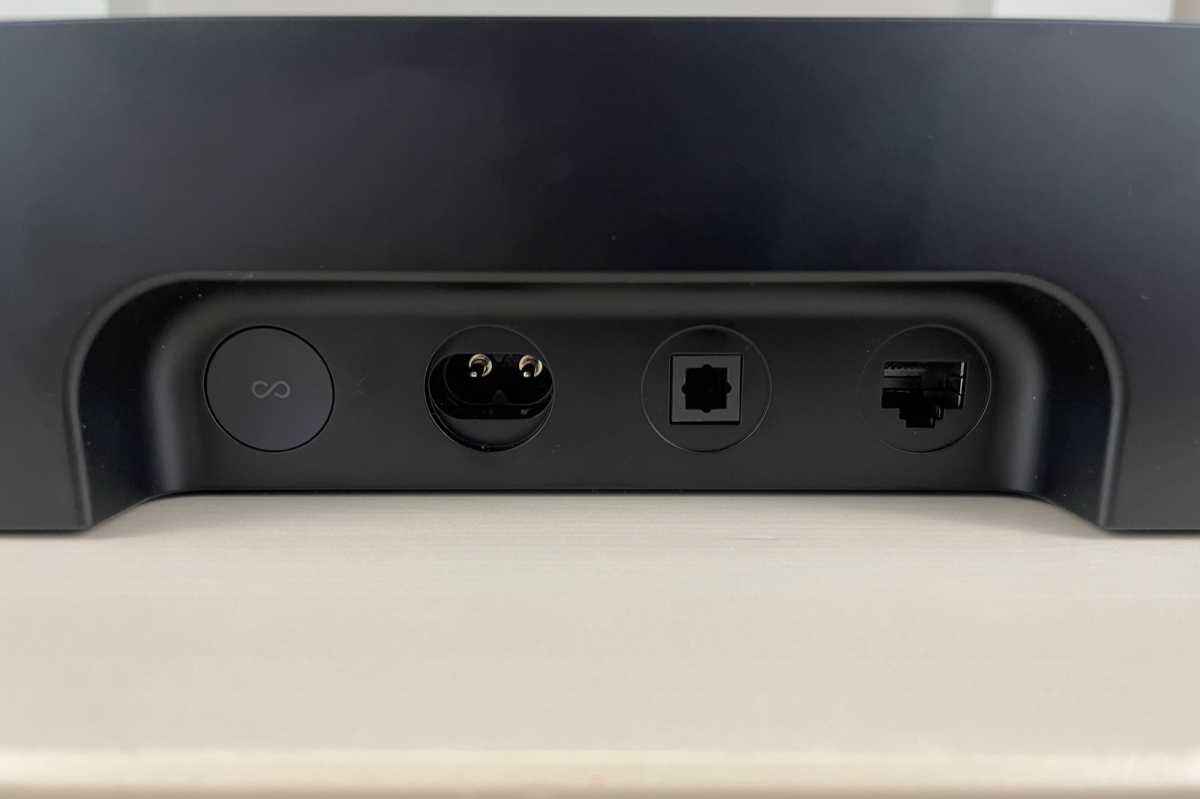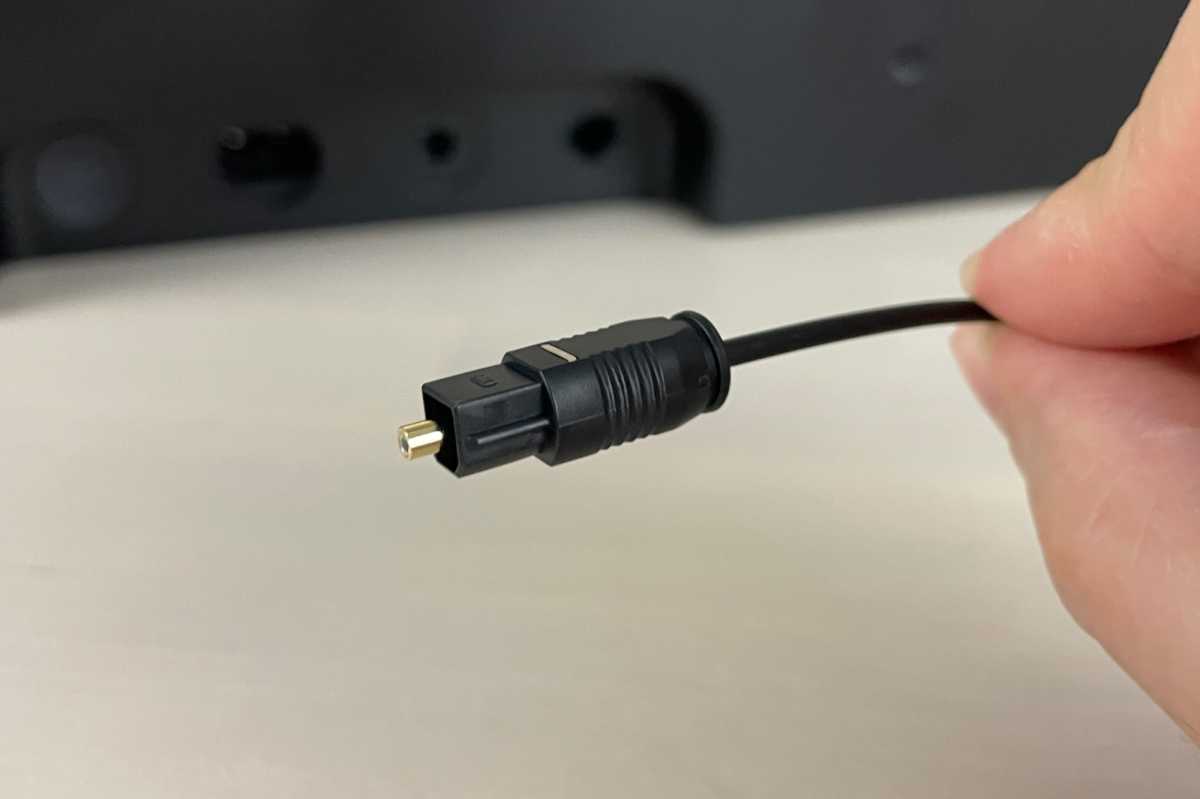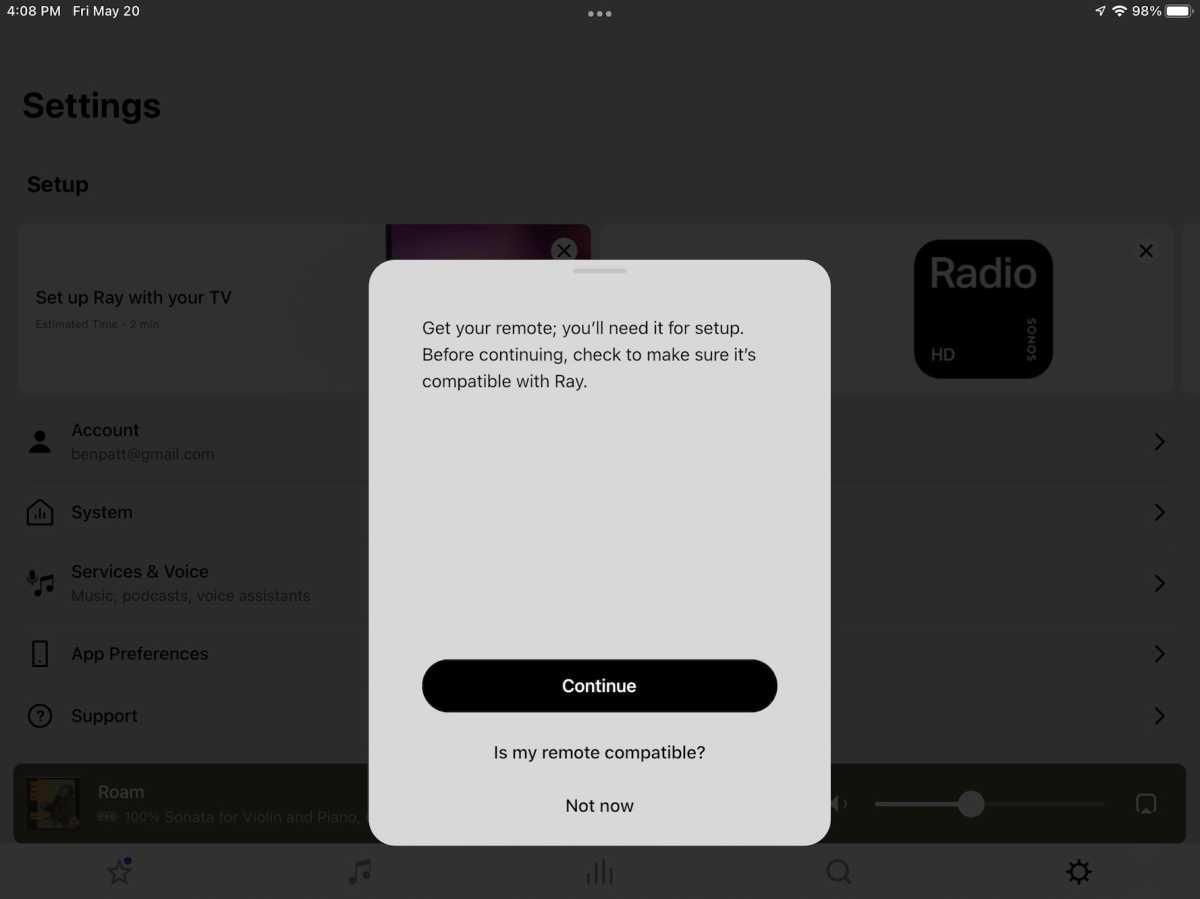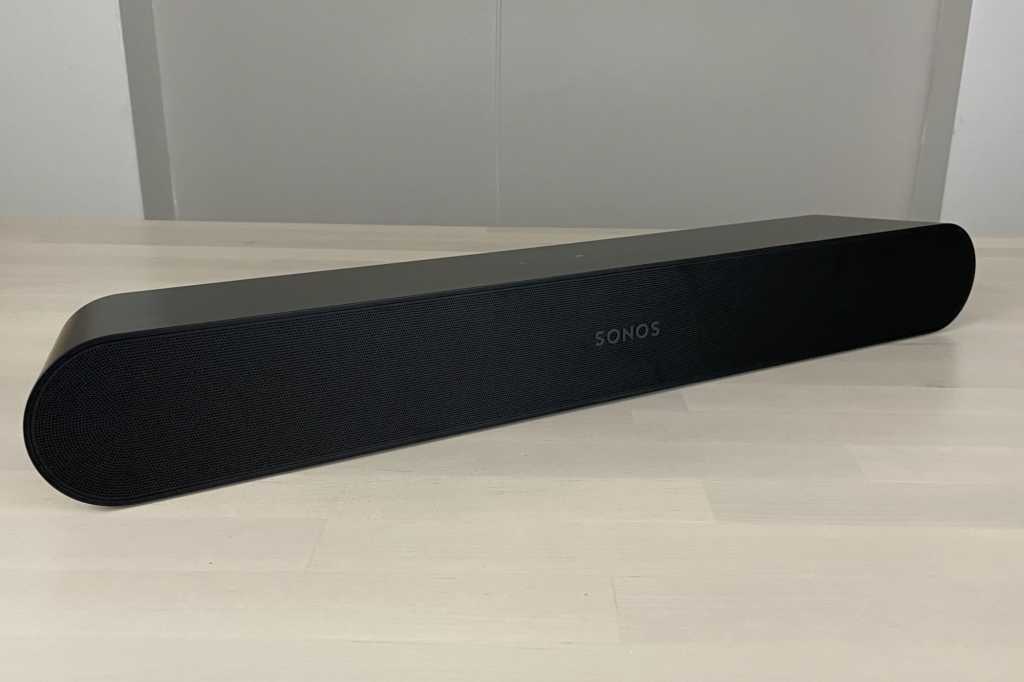Expert’s Rating
Pros
- Dynamic, musical sound with solid low-frequency performance
- Compact design
- AirPlay 2 support
- Can be supplemented by–or grouped with–other Sonos speakers
Cons
- No HDMI ports
- No Atmos or DTS:X support
- No built-in mic for voice assistants
Our Verdict
The Sonos Ray sounds terrific given its price, but the lack of HDMI holds this budget-minded soundbar back.
Price When Reviewed
$279
Best Prices Today: Sonos Ray
Sonos decided to nix two key features with the Ray, its new entry-level soundbar: Dolby Atmos and HDMI. The former makes sense; there aren’t many soundbars in the sub-$300 price range that support immersive Atmos audio, and even fewer that actually sound good. The latter omission is more problematic. Without HDMI, Ray users must fiddle with tiny and delicate optical connectors, sacrifice higher-bitrate Dolby Digital Plus audio, and manually configure (albeit with help from the excellent Sonos app) their TV remotes to work with the soundbar. Oh, and one other caveat about the Ray: There’s no built-in microphone, which means no onboard voice assistants.
That’s the bad news. The good news is that the $279 Sonos Ray (slated to ship June 9) sounds terrific for its price, packing clean, crisp, and full-bodied audio, complete with impressive bass for an all-in-one soundbar. The Ray can also be upgraded with more Sonos speakers, such as the Sonos Sub (or eventually, the rumored Sub Mini), and it works with Sonos’ best-in-class multi-room wireless audio platform, not to mention Apple’s AirPlay 2 audio-casting protocol. Finally, the Ray supports Trueplay, Sonos’s superb room-calibration feature.
This review is part of TechHive’s coverage of the best soundbars. Click that link to read reviews of competing products, along with a buyer’s guide to the features you should consider when shopping.
While I do admire the Sonos Ray’s sweet, supple, and punchy sound, it’s hard to get past its lack of an HDMI port. I can recommend the Ray for music lovers who want a larger version of the stellar Sonos One ($220) without having to fork over $550 for the One’s larger sibling, the Sonos Five. I also believe the Sonos Ray would make a good fit for a TV in a second room.
But if you’re shopping for a soundbar for your main TV, I’d recommend saving up for an HDMI- and Atmos-enabled speaker like the mid-range Sonos Beam ($449), another all-in-one soundbar with more drivers and virtualized Dolby Atmos audio, or the Sonos Arc ($899), Sonos’s top-of-the-line model with upfiring Atmos drivers. If you want to keep your budget below $300 and don’t mind leaving the Sonos realm, I recommend our current budget pick, the non-Atmos but HDMI-equipped Polk React.
Sonos Ray design and configuration
Measuring 25.63 x 2.72 x 3.94 inches (WxHxD), the Ray is Sonos’ smallest soundbar, but not by much; it’s only about three inches narrower than the mid-range Sonos Beam, and while it’s roughly 0.2 inches less deep than the Beam, it’s actually a hair taller (the Beam is just 2.72 inches tall). Happily, both the Ray and the Beam are below the 3-inch mark in terms of height, meaning they won’t block the bottom of most TVs when placed directly in front of them. Meanwhile, the flagship Sonos Arc is a full 20 inches wider than the Sonos Ray, and at 3.4 inches in height, the mammoth Arc is also somewhat taller.
Available in both black and white flavors, the Ray’s front grille is flat and perforated, with all of its drivers forward-facing, meaning you can place the soundbar in a media cabinet without worry about blocking any side-firing drivers. You can also mount the Ray under your TV with an optional wall mount ($39).
The Sonos Ray’s drivers are all forward-facing, which means you can place the soundbar in a media cabinet without worrying about blocking its sound.
Ben Patterson/Foundry
Inside the Ray’s cabinet are four drivers: two central mid-woofers flanked by a pair of tweeters, with the latter two drivers angled outward to help boost the size of the speaker’s soundstage. There’s also a passive bass-reflex setup that reinforces lower frequencies. Overall, you get a 3.0-channel audio configuration, delivering discrete left, right, and center channels, but no powered bass, no surround channels, and no height channels for Dolby Atmos.
You can upgrade the Ray with additional Sonos speakers; for example, you could use a pair of Sonos One speakers to add surround channels, which would bring the Ray up to a 5.0-channel configuration, while a Sonos Sub would turn the Ray into a full-on 5.1 system. Doing so is a pricey proposition, however, given that Sonos One speakers are $219 each and the Sub is a whopping $749. If you’re spending that much cash on a soundbar upgrade, you might be better off doing so with a more capable model, such as the Sonos Beam or Arc. Then again, the rumored–and hopefully cheaper–Sonos Sub Mini could be perfect for the Ray.
While you can upgrade the Ray with surround speakers and a subwoofer, there’s no way to add Dolby Atmos to the soundbar. Besides not having upfiring drivers for height cues or the proper internals for Atmos virtualization, the Ray lacks an HDMI connection, a requirement for Atmos and the competing DTS:X object-based audio formats. The Ray’s optical connection will support standard 5.1-channel Dolby Digital and DTS audio, although not Dolby Digital Plus, which uses less compression and higher data rates than optical connections can handle.

The Sonos Ray has optical and ethernet ports, but no HDMI.
Ben Patterson/Foundry
Sonos Ray inputs and setup
Getting started with the Sonos Ray involves little more than powering up the soundbar and (assuming you’ve already installed it) opening the Sonos app. Seconds after I opened the app, it discovered the Ray and prompted me to begin the setup process, which included connecting (seamlessly, I might add) the soundbar to my Wi-Fi network.
The app will also step you through connecting the Ray to your TV via the included (and very thin) optical cable. It’s been so long since I’ve used my TV’s optical output that I had to hunt for it with a flashlight; I also forget to remove the tiny plastic caps on either end of the optical cable (no biggie), and then it took a few tries before I remembered how to correctly orient the squarish connector. The typical female Toslink port, including the one on my TV, requires the male connector on a Toslink cable to be oriented in a specific direction. In a thoughtful touch, the female Toslink port on the Ray is designed to accept a male connector in any orientation, but you’ll probably still struggle with the TV end of the connection–just once, with any luck.
Because the Sonos Ray only has an optical connection, you’ll need to do without the magic of HDMI-CEC (short for “Consumer Electronics Control”), which allows the remotes of most modern TVs to control the volume of HDMI-connected soundbars. (Like other Sonos soundbars, the Sonos Ray doesn’t come with its own remote.) Instead, the Sonos app will help you check whether your TV remote emits IR or RF signals. After a little tinkering, I managed to get my LG C9’s remote to communicate with the Ray, but I definitely missed the seamless plug-and-play functionality of HDMI-enabled soundbars.

Behold the tiny, delicate, and finicky optical cable that comes with the Sonos Ray.
Ben Patterson/Foundry
Sonos Ray features and functionality
One of the first key features you should try on your newly installed Sonos Ray is Trueplay, the Sonos room calibration tool that measures the acoustics of the room and adjusts the audio to compensate. Once you start the Trueplay process, the Ray will start emitting a series of beeps and tones, and the Ray listens to the sounds through your iPhone’s microphone; as the Ray detects the sounds, you walk around the room, slowly waving your iPhone around as you do so. Trueplay can dramatically improve the audio performance of a Sonos speaker, but there’s a catch: it only works with iPhones and iPads, not Android devices. The reason for this, according to Sonos, is that the microphones Apple uses for its mobile devices is more or less a known quantity. It’s too difficult for the company to model its software for the wild diversity of mobile Android devices on the market.
The Ray shares more similarities with other Sonos speakers, including AirPlay 2 support and the ability to stream high-resolution tunes from music services (such as Apple Music, Spotify, Amazon Music, Audible, Deezer, Pandora, TuneIn, iHeartRadio, YouTube Music, and Sonos’ own Sonos Radio) via the Sonos app. The Sonos app will also let you group the Ray with other Sonos speakers for multi-room listening.

The Sonos app will step you through the process of making your TV’s remote work with the Ray.
Ben Patterson/Foundry
A key feature that the Sonos Ray lacks is a microphone, meaning there’s no support for built-in voice assistants such as Alexa, Google Assistant, or the upcoming Sonos Voice Control. But while the Ray can’t host a voice assistant, it does work with them, meaning you can tell an Amazon Echo, a Google Nest speaker, or a mic-equipped Sonos speaker to (for example) adjust the Ray’s volume or play or pause your tunes.
As with other Sonos soundbars, the Ray lacks sound modes such as Movie, Music, Sports, and so on; instead, you get what you get, which is probably for the best. That said, there are voice enhancement and night modes, while treble and bass sliders give you some basic audio adjustments.
Sonos Ray performance
Perhaps because the Sonos Ray is an optical-only soundbar, I began my listening sessions with lowered expectations, which were quickly exceeded by the Ray’s clean, crisp, and punchy performance. Yes, I’ve heard better from the Sonos Beam and Arc, but the Ray still packs an impressive amount of bass for an all-in-one soundbar, with plenty of dynamics and a wide, spacious soundstage considering the Ray’s size.
I hopscotched through a variety of movies to test the Sonos Ray’s audio, from Indiana Jones and the Crystal Skull (am I the only one who liked that movie?) and Star Wars: The Empire Strikes Back on Blu-ray to Top Gun and 1979’s Superman on the iTunes store. Some of the highlights include the impressively loud crack when Indy shoots a Russian soldier in the foot during Crystal Skull’s opening action sequence, a dynamic moment that’s matched in Empire when a sprinting Luke fires a grappling hook at an Imperial Walker, hitting its belly with a solid, satisfying thwack!
Naturally, the Ray’s passive bass ports can’t compete with the low frequencies of an external subwoofer; in other words, don’t expect to hear–or feel–the ultra-deep booms of an Imperial Walker’s feet as it stomps across the icy tundra on Hoth. That said, the Ray still managed to dish out an impressive amount of bass considering its size and all-in-one design, such as the kerplunks of the pistons in the engine room of the Titanic, or the booming afterburners of an F-16 in Top Gun.
I also found the Ray to be a very musical soundbar. John Williams’ rousing Superman score sounded crisp yet full, with a pleasing but not overly-sweet tone, while James Horner’s soaring yet ethereal “Southampton” theme as the Titanic leaves port was lively without ever turning shrill.
Speaking of musicality, the Sonos Ray excels as a music speaker. Bruce Springsteen’s “The Ghost of Tom Joad” sounded spare, clean, and–most importantly–alive, with nice atmospherics and a warm, gentle glow of bass. Billie Eilish’s “Oxytocin” has the potential to blow out the woofers in some all-in-one soundbars, but the Ray’s bass ports deftly handled the track’s deep, aggressive bassline. The Ray also packed a punch with the big, powerful timpani that bridge the third and fourth movements of Shostakovich’s Violin Concerto No. 1.
Sonos Ray: The bottom line
I get why a budget soundbar like the Sonos Ray would drop Dolby Atmos support, and even losing the onboard voice assistants makes sense. But skipping HDMI is a tougher pill to swallow; after all, HDMI has become nearly ubiquitous in the Ray’s price range and even lower (consider the Roku Streambar, for example).
That’s why I’m mainly recommending the $279 Sonos Ray as either a) an excellent mid-range music speaker and/or b) a great match for a TV in a second room, or perhaps a studio apartment. If you want a reasonably priced Sonos soundbar in your main TV room, I’d suggest investing an additional $170 for the HDMI- and Atmos-enabled Sonos Beam, a setup that could truly grow over time. Finally, if you’re dead-set on a sub-$300 soundbar, consider the HDMI-equipped Polk React instead.

